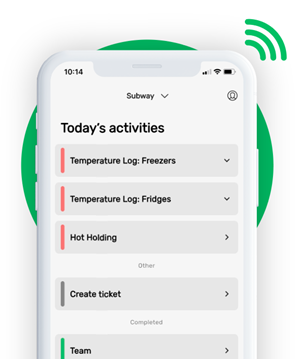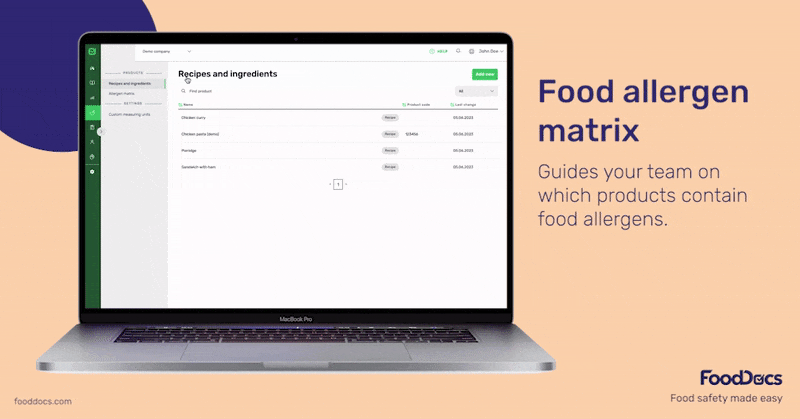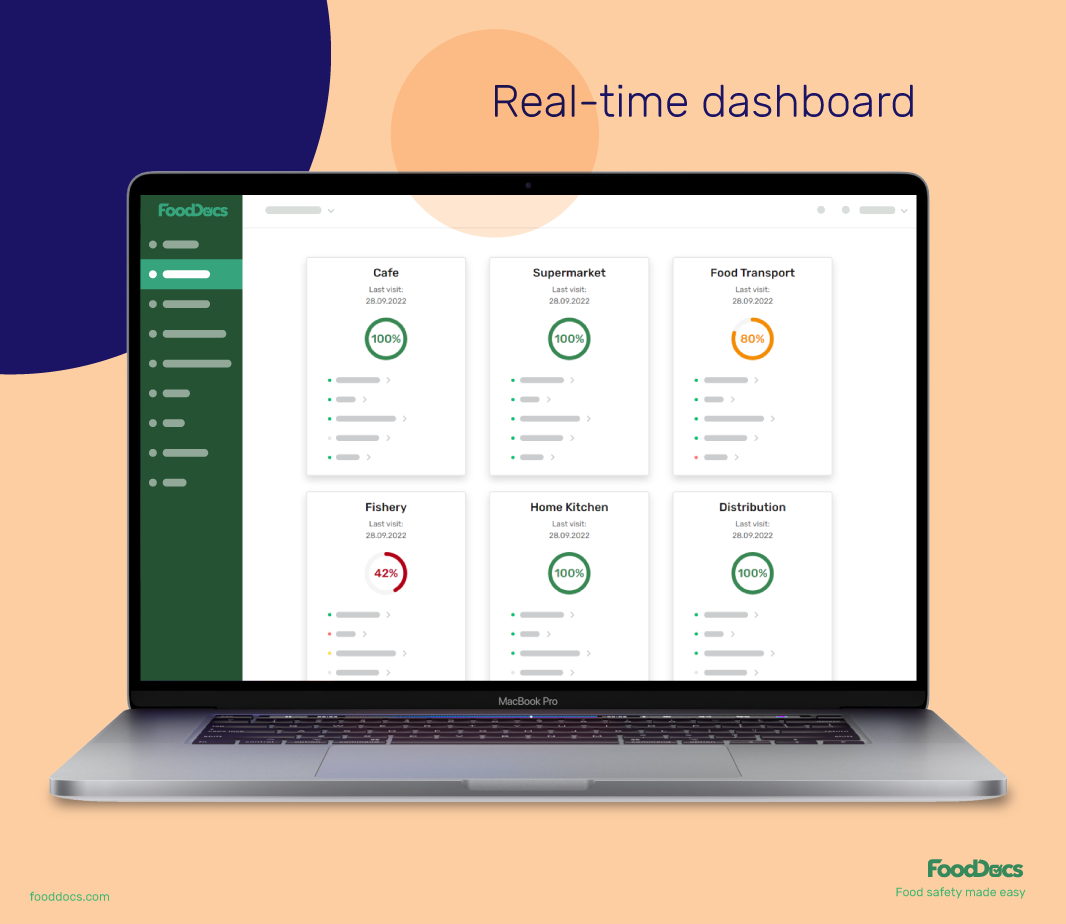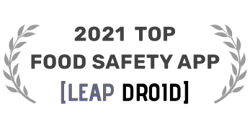FOOD ALLERGEN POSTER PDF | FREE DOWNLOAD
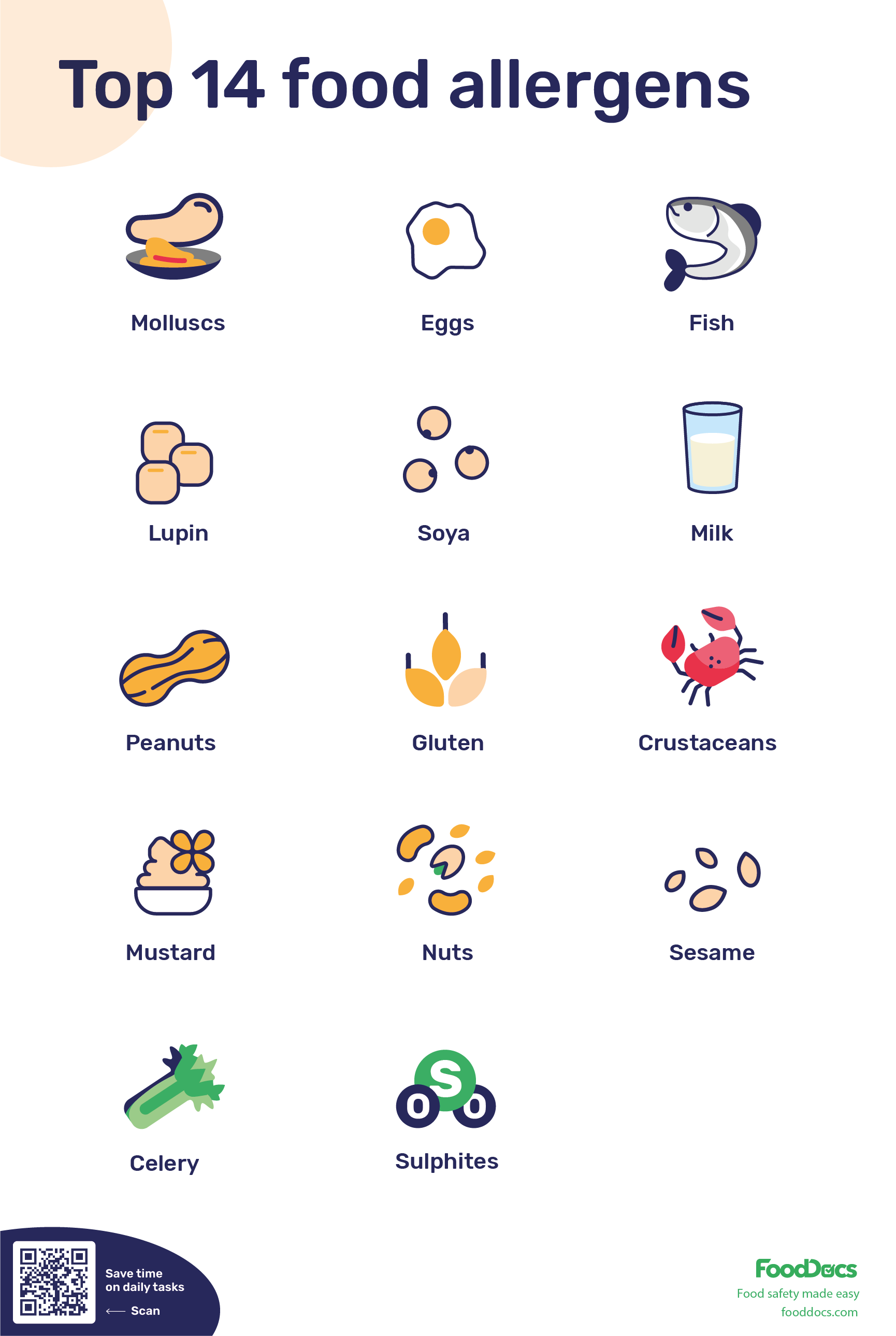



This is how our Digital Food Safety platform saves 20% of your time on daily tasks:
- Get upcoming task notifications
- Add data into the app
- Check the status of tasks in real-time

When food safety was still handled on paper, I typically spent a couple of hours per day getting the papers and going around checking or completing tasks… Now I can sit down and it's just all there in one place. It takes me 5-10 minutes.
Ruth B.
Store Manager
As food allergies continue to rise, is your business doing enough to keep your customers safe from major food allergens? Dive into how our easy-to-use free food allergen poster can help you meet legal requirements and safeguard health, making your food business safer and more trustworthy.
Key takeaways
- Food allergies are common in the UK, affecting millions annually, with reactions ranging from mild itching to severe anaphylaxis.
- A food allergen poster serves as crucial guidance for both employees and consumers about the 14 major food allergens.
- Strict allergen laws like Natasha's Law require food businesses to provide detailed ingredient and allergen information on labels, enhancing consumer safety.
- The food allergy poster is an essential tool in food safety management, helping to prevent cross-contamination and ensuring compliance with food law requirements.
- Although not legally mandated, displaying a food allergy notice poster can significantly enhance allergen awareness among staff and patrons.
- FoodDocs' food safety software makes allergen management simple with an automated allergy matrix, smart recipe book, cleaning logs in an intuitive mobile app, and more.
WHAT WE'LL COVER:
- Introduction to Food Allergies in the UK
- Understanding the Importance of a Food Allergen Poster
- Legal Implications of Natasha’s Law for Food Businesses
- How to Effectively Use a Food Allergy Poster
- The 14 Major Food Allergens Explained
- Essential Documents for Allergen Management
- How FoodDocs can help
A brief overview of food allergens
More than 2 million people in the UK experience food allergic reactions each year. It's around 1-2% of adults with food allergies and 8% of children, which is rising yearly. It has been estimated that around 2 million people with allergies in the UK.
Allergic reactions are mostly mild, like hives, itching, or eczema. Although, in some cases, even a tiny amount of the allergy-causing food can cause a life-threatening reaction such as swollen airways.
Food allergies are very manageable as long as consumers know which food are they allergic to. As a food business owner, you must disclose which potential major allergen may be in your finished products.
Some foods may not have some of the major allergens but may have been derived from them. Such is the case for lecithin, which may be made of soy. The lack of information and the presence of allergens may cause a severe public health issue.
This is why strict food allergen laws such as Natasha's Law have been established. This food legislation aims to inform customers about the allergens used by requiring food companies to disclose all food information including ingredients and allergens in their products.
Understanding Natasha’s Law and allergen labelling regulations
Under the UK Food Information Amendment 2019 (Natasha’s Law), all prepacked foods for direct sale (PPDS) must have a full ingredients list on the label with allergens emphasized, typically in bold.
This regulation applies to:
- Foods packaged on-site before being offered for sale (like sandwiches or salads in a café fridge)
-
Items not ordered or packaged at the customer’s request
Non-compliance may result in improvement notices, fines, or even prosecution. For other food types (non-prepacked or restaurant food), allergen information must still be provided either:
- In writing (e.g. menus, leaflets, chalkboards)
-
Verbally, with signage informing customers they can ask staff
The law requires this information to be indicated in the labelling for all pre-packed foods for direct sale. Non-compliance with these labelling requirements can be considered as a criminal offence.
Our free food allergy notice poster will help your food officers remember easily the list of allergens that cause 90% of all food allergies and protect your customers.
How will the food allergen poster PDF help me?
We know from our own experience that as a food business, your team is always busy serving customers and you as an owner, chef, or manager are responsible for running the successful business. One of the biggest challenges in business practices is to train your team to handle food safely, including avoiding cross-contamination in food preparation when handling food allergens.
If the customer has a food allergy, even a tiny piece of allergens in food can trigger a reaction. That's why it's crucial to have a clear food allergy poster pdf to display in your workplace - so your kitchen team will see all 14 major allergens and the allergenic risk involved at a glance. Your food allergen poster's main objectives include the following:
-
Notice for consumers: A food allergen poster template must be placed where it is noticeable by everyone who enters or buys any of your finished product. It must also be clear and well written so customers can read it. In addition to appropriate allergen labelling, your food allergen poster must indicate all 14 major allergens and where possible, indicate which ones are most applicable to your current shop products. It can be an important form of guidance for food businesses.
-
Reminder for employees: Your food allergens safety sign must also be posted where it is visible in the production area or where your employees usually handle common foods. This poster will serve as a notice for employees of the important allergens and remind customers of them. Food business operators must undergo food allergy training exercises to remind or ask consumers of any known allergies they have to ensure that they will not be served with any allergenic foods they are sensitive to.
-
Compliance with requirements of food law: According to Natasha's Law, all food businesses in England, Wales and Northern Ireland are required to provide a full ingredients list and allergen on foods packed for sale on their premises.

Is a food allergen awareness poster mandatory?
Natasha's Law requires businesses to label the food with a complete list of ingredients to make it easier for consumers to identify and avoid foods that contain food allergens. Under the mandate of the Food Standards Agency, you are required to display the clearest food allergy notice and allergen advice statement in any of these forms:
-
Precautionary allergen statement on your menu, on a chalkboard, on a leaflet, or on an information pack
-
An allergy warning or sign explaining how customers can gain the information (e.g. asking the employees)
-
Allergy awareness materials of the 14 major allergens.
Indicating allergen content can be on the packaging, labels, or a statement for customers to ask staff about food allergies. A food allergy notice poster is not a legal requirement, but it is helpful to remind your kitchen team regarding the 14 major allergens.
How to use the food safety allergen poster?
The food allergy notice poster lists all major allergens with clear and simple illustrations. Your poster must be easy to see at once in your food establishment which foods may cause food allergies and remember them easily.
Display this poster where all your current team can see it on the walls near the working zone. Keeping a food allergy poster pdf in front is especially important when serving high-risk customer groups like the elderly, children, or people with low immunity systems.
What are the 14 major allergens in the UK?
Here’s the list of allergens you must declare under UK law: celery and celeriac, cereals containing gluten, crustaceans, eggs, fish, lupin, molluscs, milk, mustard, nuts, peanuts, sesame seeds, soybeans, sulphur dioxide, and sulphites. These allergens cause the majority of food allergy-related cases in the UK.
| Allergen | Common Sources |
|---|---|
| Celery | Stock cubes, soups, spice mixes, salads, celery salt |
| Cereals containing gluten (e.g., wheat, rye, barley, oats) | Bread, pasta, flour, pastry, batter |
| Crustaceans (e.g., prawns, crab, lobster) | Shrimp paste, prawn crackers, seafood dishes |
| Eggs | Cakes, mayonnaise, mousse, quiche, sauces |
| Fish | Fish sauce, pizza toppings, salad dressings, stock cubes |
| Lupin | Bread, flour, pastries, some pasta types |
| Milk | Butter, cheese, yogurt, cream, powdered soups |
| Molluscs (e.g., mussels, squid, oysters) | Bouillabaisse, paella, seafood pasta |
| Mustard | Curries, marinades, salad dressings, sauces |
| Tree nuts (e.g., almonds, hazelnuts, walnuts) | Nut oils, cakes, pesto, desserts |
| Peanuts | Peanut butter, cakes, curries, sauces, biscuits |
| Sesame seeds | Breads, crackers, hummus, tahini |
| Soybeans | Tofu, soy sauce, lecithin in chocolate or baked goods |
| Sulphur dioxide (sulphites) | Dried fruits, soft drinks, wine, pickles |
These allergens must be declared even if used in compound ingredients (like mayonnaise or soy lecithin).
Below, we go into more detail about each of the top 14 allergens UK list:
1. CELERY
2. WHEAT
Wheat allergy is tightly related to a very widespread disease called celiac. Celiac is a reaction to a protein fraction called gluten in food, found in wheat and wheat-related cereals such as rye, oats, and barley.
As gluten is widely used in processed food, such as baking powder, batter, breadcrumbs, bread, cakes, couscous, meat products, pasta, pastry, sauces, soups, and fried foods are dusted with wheat flour, allergic people are in trouble trying to avoid it. Allergic reactions to the presence of gluten can cause hives, nausea, vomiting, stomach cramps, and even a stuffy nose.

3. CRUSTACEAN SHELLFISH (shrimp, crab, lobster, and scampi)
Allergy to crustacean shellfish also appears, especially in regions where the consumption is higher. Also, it's important to remember that shellfish retain their allergic features even after heating. People with a crustacean allergy may also suffer from molluscs (mussels and clams), allergies, and fish.
Shellfish is mainly used in shrimp paste, and often used in Thai and Southeast Asian curries or salads. Allergy to shellfish is caused by the immune system when it mistakes the protein tropomyosin as an allergenic substance. Symptoms of shellfish allergic reactions can be very mild but can sometimes be life-threatening.
4. EGG
Egg food allergy is also widespread among children and is also often outgrown by the age of 6. The egg white is a part of the egg that more often causes a food allergy than egg yolk.
Since eggs are often used in food products like cakes, meat products, mayonnaise, mousses, pasta, quiche, sauces, pastries, or foods brushed or glazed with egg, always check the ingredients.

5. FISH
Fish allergy can be surprising in some areas, but it's most common in places with higher fish consumption. Mostly the reactions are mild, but in some rare cases, they can be more severe.
As there is a great range of different species, food allergy mostly applies to different species, including salmon, cod, halibut, haddock, tuna, and anchovies. Fish is usually used in fish sauces, pizzas, relishes, salad dressings, stock cubes, and Worcestershire sauce.

6. LUPIN
Although lupin is a flower, it's also found in flour! Lupin flour and seeds are used in some types of bread, pastries, and pasta. Lupin is closely related to peanuts since it is also a legume. Lupin allergy can be present in both peanut and non-peanut allergy-related cases.
Cross-reactivity with lupin allergy in patients who are allergic to peanuts has been reported in some cases. This means that some people with peanut allergies have been observed to have allergies to lupin as well.
7. MILK
Milk allergy is the most common among children, but in 90% of cases, children will outgrow the allergy by the age of 6. Milk is a widely used ingredient in butter, cheese, cream, milk powders, and yogurt. It's also used in powdered soups and sauces.
Although equally require caution, milk allergy and lactose intolerance are not the same. Lactose intolerance is caused by the body's inability to process lactose, whereas milk allergy is related to the body's immune system.
8. MOLLUSC
Molluscs include clams, oysters, mussels, land snails, whelks, squids, and octopuses. The allergic reaction to these kinds of seafood is caused by the body's reaction to their tropomyosin content.
9. MUSTARD
This includes mustard in powder, liquid, and seeds that are mostly used in bread, curries, marinades, meat products, salad dressings, sauces, and soups. Allergic reactions to mustard can be very dangerous. Some reactions can just manifest as hives with dizziness, whereas some can lead to anaphylactic shock that causes blockage of your throat and prevent breathing.
Mustard allergy is common in countries that use spices the most, such as the UK, Canada, and India. Cross-reactivity to other foods such as rapeseed, broccoli, cabbage, brussels sprouts, and turnips have been reported previously.
10. TREE NUTS
Tree nuts include cashew nuts, almonds, hazelnuts, walnuts, cashews, pecan nuts, brazil nuts, pistachio nuts, and macadamia (Queensland) nuts. Tree nuts are known as the cause of the most severe food allergies in the world.
They are also coincidentally one of the most frequently occurring allergies. This is why tiny amounts of food item can trigger severe reactions, and strict avoidance is essential.
11. PEANUTS
Peanuts allergy is the most popular among children, and it has tripled in the last twenty years. At the same time, it's considered the most dangerous food allergy for children, as a low dose can cause fatal reactions.
Allergic reactions to peanuts usually take only a few minutes to manifest. Peanuts are often used in biscuits, cakes, curries, desserts, sauces, groundnut oil, peanut butter, and peanut flour.
12. SESAME
Sesame includes sesame seeds, sesame oil, benne, benne seed, gingelly and gingelly oil. Named ingredients are usually used in bread, usually sprinkled on buns such as hamburger buns, breadsticks, hummus, sesame oil, and tahini.
13. SOYBEAN
Like wheat, soybean is also difficult to avoid as it is used in many processed foods - including tofu, miso paste, soy sauce, soya flour, soya milk, and soya oil. Soya is also a staple ingredient in oriental food. Vegetarian food products often include soybeans as a substitute for meat protein.
Soy can also be in forms that are very hard to anticipate, such as in lecithin, which is commonly used as an emulsifier for compound chocolates and can trigger allergic reactions in excessively large amounts of intake.
14. SULPHUR DIOXIDE (Sulphites)
Sulphur Dioxide is often used as an ingredient in dried fruits, meat products, soft drinks, vegetables, wine and beer. Keep in mind that asthmatics have a higher risk of developing an allergy to sulphites.
Sulphides are widely used in pickled foods and vinegar and dried fruit, e.g. dried apricots, prunes, raisins etc. It is commonly used as an antioxidant to prevent browning in products as well as inhibit microorganisms.
What other allergens are worth knowing about (beyond the top 14)?
While only 14 allergens are legally required to be declared, other ingredients can still trigger allergic reactions. These include:
- Alliums: Garlic, onions, leeks
- Fruits: Kiwi, strawberries, citrus fruits
- Legumes: Lentils, chickpeas
-
Mycoprotein: Quorn (a fungus-based protein)
Although not required by law, it’s smart practice to ask customers about any known allergies, even outside of the top 14. It’s part of good food safety culture.
How to handle allergens in your food business (a quick guide)
Here’s a 5-step process to help ensure allergen-related food safety compliance:
1. Identify allergens in every ingredient and menu item
Conduct a full audit of all the ingredients used in your kitchen, including sauces, marinades, and pre-packed items. Document which of the 14 major allergens appear in each dish. Don’t forget to include ingredients from suppliers, which may contain hidden allergens.
2. Label and highlight allergens on menus, packaging, or product tags
Make sure allergens are clearly indicated on printed materials. For prepackaged foods, use bold type or contrasting fonts to highlight allergens in the ingredients list. For non-prepacked foods, include an allergen statement on menus and train staff to explain it accurately.
3. Display signage encouraging customers to ask about allergens
Place clear notices in customer areas inviting people to speak to staff about allergens. Use wording like “Please inform a staff member if you have any food allergies” to prompt these conversations and protect at-risk customers.
4. Train staff using allergen awareness training and visual reminders
Staff should know the 14 allergens, how to avoid cross-contact, and what to do when a customer reports an allergy. Regular training, visual aids like posters, and quizzes can keep knowledge fresh and aligned with FSA recommendations.
5. Verify and monitor allergen handling regularly using checklists or software
Set up internal checks to ensure procedures are being followed. Use digital tools or checklists to verify labelling accuracy, proper storage of allergenic ingredients, and cleaning protocols to prevent cross-contact. Make this part of your daily food safety routine.
What documents do I need to manage allergens?
Visits and inspections by local authorities might be challenging, especially when you don't have all food safety-related documents prepared. Accurately informative materials for the team are clear pieces of evidence for authorities that your food business takes food safety seriously.
Be ready for the food safety inspection and use our free food allergy notice poster template to create your own.
Important food allergy documents include:
- Food allergen sheets template to help your team inform customers about menu items containing allergens. An allergen chart is a document that contains the food items on your menu and the allergens they may contain. It is a simple overview of the necessary information that is important to be disclosed to the customers.
- Food allergen poster PDF to help your kitchen team to remember all 14 allergens. This food allergy awareness poster is a list of the 14 major food allergens and some of the common dishes that may contain them.
- Food allergen management plan is an essential chapter of your HACCP plan of prerequisite programme chapter. Identification of allergenic ingredients is considered a critical process to protect your consumers and ensure food safety. Appropriate preventive controls, monitoring procedures, and verification activities will be derived based on the identification of the allergens in your products.
Suppose you're unsure where to start with your food allergy documents or don't have enough time. FoodDocs HACCP builder will direct you through the HACCP process and get your food allergen poster PDF done in no time so you can focus on growing your business.
Get the important documents and procedures you need to fulfill when making a HACCP food safety management program.
Easily manage food allergens with FooDocs' software
The effects of major food allergens on people with allergies could be life or death. The lives of your customers may be in jeopardy if you don't properly control allergens. This is why it's essential to train your food safety team on proper procedures for handling allergens. Thankfully, FoodDocs' food safety monitoring software simplifies this for food service and production companies.
Proper food business awareness training, correct tools, and a comprehensive food safety management system are keys to protecting customers with allergies to foods.
FoodDocs also offers a smart, digital solution for your food safety team. Our digital solution can help you through the following features:
- Smart notification system. This feature sends intuitive alerts to food handlers regarding a task that needs to be done on time. Similarly, this feature can be used to remind food business staff regarding highly perishable products and their use-by dates. Using this feature, no food safety task will be left undone.
-
Cleaning checklist solution. Our system can generate a cleaning checklist which you can use to verify if all allergen containing foods are labelled, stored correctly, and separated from the non-allergenic foods to reduce food safety risks.
Features that are most beneficial for managers
- Recipe management feature. Using this, our system can guide your food handlers on which allergens are in your dishes. Your team will always be properly oriented on which dishes to warn customers with food allergy intolerance which might just save their lives.

-
Automatically generated monitoring forms. When you sign up with us, our system can automatically generate the most important monitoring forms and checklists based on your food safety operations. These monitoring forms are equipped with an auto-fill feature that can help your employees save time. The information logged into the forms are based on previously inserted data. All that is left to do is to verify the informaion.
-
Real-time dashboard. Our digital solution also features a dashboard that gives you an overview of your everyday operations. Save at least 20% of your time from supervising your operations and identify which areas you need to focus on.
-
Cloud storage. You also get a digital storage area where you can store, organize, and access everything easily.
You can get all of these features and more when you sign up for our digital Food Safety Management System. The process only requires you to answer a few basic questions regarding your food safety operations. In an average of 15 minutes, our system can automatically generate a digital FSMS for you, so you can start monitoring right fast.
With a few clicks, you can get a comprehensive food safety compliance system that is powered by artificial intelligence. You can maintain food safety compliance effortlessly and have more time to improve your business operations.

Frequently asked questions about food allergens in the UK
Has Brexit changed the UK’s allergen labelling requirements?
No. The UK retained the same list of 14 allergens post-Brexit. Businesses must still follow the existing Food Information Regulations.
Is a food allergen poster mandatory under Natasha’s Law?
No, but it supports compliance. Natasha’s Law requires full ingredient and allergen labelling for PPDS foods, but posters help staff stay aware.
Can I verbally communicate allergen info to customers?
Yes, for non-prepacked foods, verbal communication is allowed—but you must have staff trained and signage inviting customers to ask.
What’s the best way to keep track of allergens in my kitchen?
Use an allergen matrix, regular staff training, clear signage, and tools like allergen management software to stay on top of compliance.
